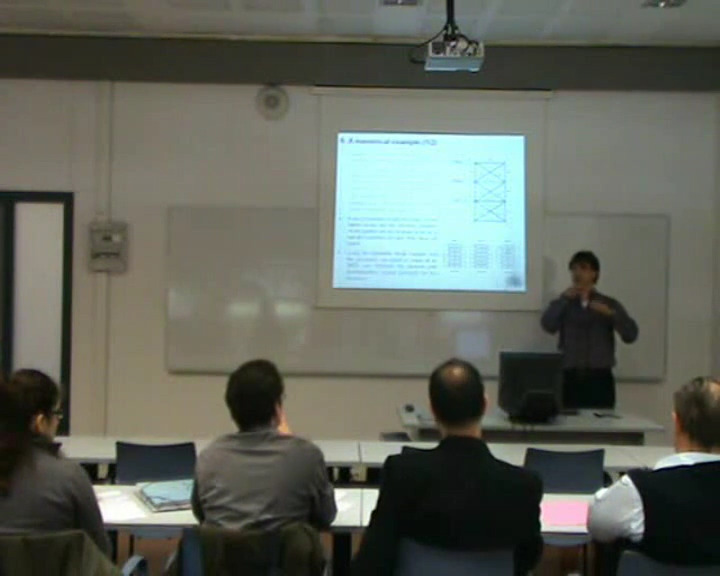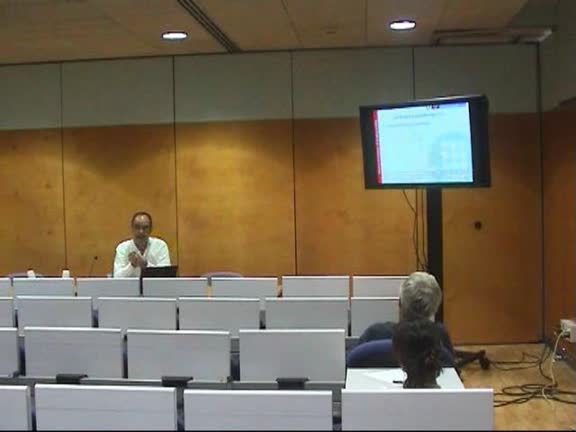A simulation-based algorithm to predict time-dependent structural realiability
Accés obert
19 de nov. 2008
2
visualitzacions
Juan Alejandro Juan Pérez
L’Institut d’Estadística i Matemàtica Aplicada a l’Edificació (IEMAE) recull propostes en el sector de l’edificació sostenible de professors de diferents departaments de l’EPSEB de forma transversal i en aquest context dinamitza i dóna suport a l’activitat dels seus membres en l’àrea de l’Estadística i Matemàtica Aplicada orientades a noves metodologies i les seves aplicacions.
Dins del Seminari de l'Institut trobem la següent exposició en català a càrrec del Dr. Àngel A. Juan, del Departament de Matemàtica Aplicada I (EPSEB-UPC)
Llicència: Reconocimiento-NoComercial-SinObraDerivada 3.0 España (CC BY-NC-ND 3.0 ES)
Vídeos de la mateixa sèrie
A simulation-based algorithm to predict time-dependent structural realiability
Accés obert
19 de nov. 2008
L’Institut d’Estadística i Matemàtica Aplicada a l’Edificació (IEMAE) recull propostes en el sector de l’edificació sostenible de professors de diferents departaments de l’EPSEB de forma transversal i en aquest context dinamitza i dóna suport a l’activitat dels seus membres en l’àrea de l’Estadística i Matemàtica Aplicada orientades a noves metodologies i les seves aplicacions.
Dins del Seminari de l'Institut trobem la següent exposició en català a càrrec del Dr. Àngel A. Juan, del Departament de Matemàtica Aplicada I (EPSEB-UPC)
Dins del Seminari de l'Institut trobem la següent exposició en català a càrrec del Dr. Àngel A. Juan, del Departament de Matemàtica Aplicada I (EPSEB-UPC)
Survival Analysis Techniques Applied to Building Maintenence
Accés obert
27 de maig 2009
This contribution has two main objectives: On the one hand, we want to introduce survival analysis techniques for use in building maintenance and, on the other hand, to apply this methodology to analyzing a large building stock in order to obtain information for maintenance strategies and/or prevention policies.
Similar to technical systems, buildings and their elements are also subject to aging. They age even faster when they are exposed to external (sometimes extreme) weather conditions. In this paper we are particularly interested in describing the time to the event when the event of interest is some damage (or level of degradation) on the building façade which can represent some risk for people (inside or outside the building). For the time being, building follow-up is based on inspections. Data coming from building inspections is always inaccurate, but censored, due to the fact that, at each inspection time, the event of
interest has already happened, or not yet happened. We have adapted the existing methodology for fields like medicine, biology, industrial engineering or event history analysis, and we have implemented in SPLUS®, by Insightful®, the routines for a numerical and graphical systematic analysis.
The potential of this proposal is illustrated with its application to a real dataset. We have been collecting data for years from all the buildings façades in Hospitalet de Llobregat, the second most populous city in Catalonia (Spain). More than 10,000 buildings have been inspected and an exhaustive checklist has been completed for each one. The analysis of the results allows technicians to detect different zones and levels of intervention to be applied in the city.
L’Institut d’Estadística i Matemàtica Aplicada a l’Edificació (IEMAE) recull propostes en el sector de l’edificació sostenible de professors de diferents departaments de l’EPSEB de forma transversal i en aquest context dinamitza i dóna suport a l’activitat dels seus membres en l’àrea de l’Estadística i Matemàtica Aplicada orientades a noves metodologies i les seves aplicacions. Dins del Seminari de l'Institut trobem l'exposició en català a càrrec del Carles Serrat i Pié professor del departament de Matemàtica Aplicada I (EPSEB-UPC).
Similar to technical systems, buildings and their elements are also subject to aging. They age even faster when they are exposed to external (sometimes extreme) weather conditions. In this paper we are particularly interested in describing the time to the event when the event of interest is some damage (or level of degradation) on the building façade which can represent some risk for people (inside or outside the building). For the time being, building follow-up is based on inspections. Data coming from building inspections is always inaccurate, but censored, due to the fact that, at each inspection time, the event of
interest has already happened, or not yet happened. We have adapted the existing methodology for fields like medicine, biology, industrial engineering or event history analysis, and we have implemented in SPLUS®, by Insightful®, the routines for a numerical and graphical systematic analysis.
The potential of this proposal is illustrated with its application to a real dataset. We have been collecting data for years from all the buildings façades in Hospitalet de Llobregat, the second most populous city in Catalonia (Spain). More than 10,000 buildings have been inspected and an exhaustive checklist has been completed for each one. The analysis of the results allows technicians to detect different zones and levels of intervention to be applied in the city.
L’Institut d’Estadística i Matemàtica Aplicada a l’Edificació (IEMAE) recull propostes en el sector de l’edificació sostenible de professors de diferents departaments de l’EPSEB de forma transversal i en aquest context dinamitza i dóna suport a l’activitat dels seus membres en l’àrea de l’Estadística i Matemàtica Aplicada orientades a noves metodologies i les seves aplicacions. Dins del Seminari de l'Institut trobem l'exposició en català a càrrec del Carles Serrat i Pié professor del departament de Matemàtica Aplicada I (EPSEB-UPC).



